Unlike domesticated, managed honey bees that nest in human-made hives, most wild bees are solitary (they don’t nest in a colony) and need appropriate nesting sites in our gardens and landscapes. The majority of wild bees nest in the ground; the minority are cavity nesters. Attracting ground-nesting bees to your garden can be difficult, but attracting small carpenter bees is quite easy, because they nest in plant stems.
Small carpenter bees get their common name from their nesting behavior. Females chew the soft pith from the center of a plant stem to excavate the cavity for their nest. They cannot chew through the tough exterior of the outside of a stem, and therefore need an opportunistic opening (created by another boring insect) or a stem that has a broken end revealing the central pithy area. Small carpenter bees are related to carpenter bees (
Xylocopa spp), which can be destructive wood-boring nesters. Small carpenter bees, due to their size, are not likely to cause damage to structures or buildings; they prefer to nest in plant stems or rotting wood, such as a log on the ground.
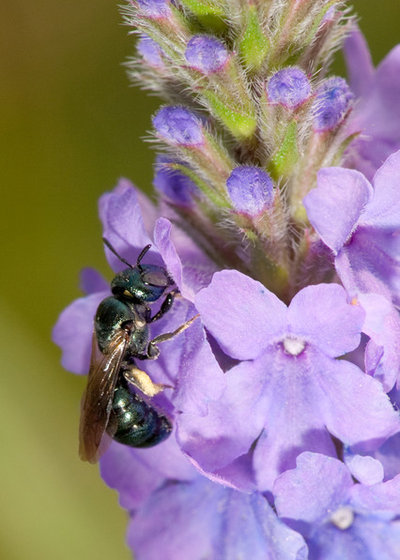
Holm Design & Consulting LLC
Latin name: CeratinaCommon name: Small carpenter bee
3 subgenera in North America: Ceratinula,
Zadontomerus and
Calloceratina (north of Mexico), comprising 22 species
Species in the upper Midwest to Northeast: Spurred ceratina (
Ceratina calcarata),
doubled ceratina (
Ceratina dupla),
nimble ceratina (
Ceratina strenua),
Ceratina mikmaqi and Cockerell’s ceratina (
Ceratina cockerelli)
, whose main range is the Southeast
Distribution: Small carpenter bees are found throughout most of the world, including Asia, Africa, Europe, South America and North America; they are rare in Australia.
Habitat: Near woodlands and in gardens, meadows, prairies and old fields
Shown: Female small carpenter bee on hoary vervain (
Verbena stricta)
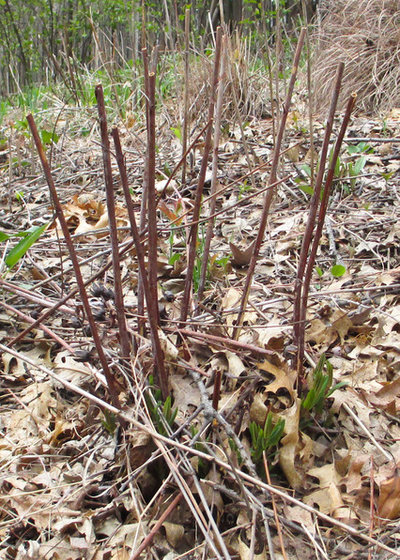
Holm Design & Consulting LLC
When to look for them: You will see small carpenter bees visiting flowers throughout the growing season, from early spring through fall. These tiny bees visit some of the first spring woodland wildflowers, like hepatica (
Hepatica spp) and bloodroot (
Sanguinaria canadensis).
Shown: The stubble of perennial plant stems, 12 to 15 inches tall, which provides nesting sites for small carpenter bees and other cavity-nesting insects
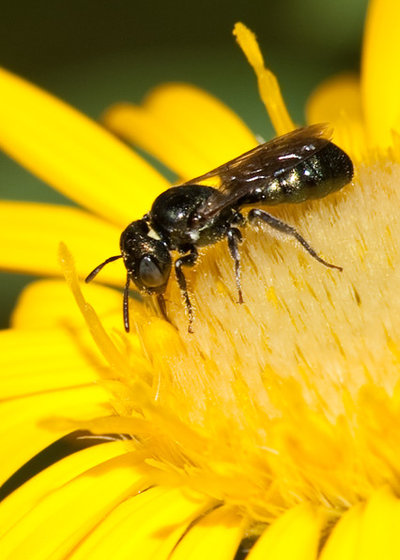
Holm Design & Consulting LLC
How They HelpThey pollinate flowers, of course. Although small in size, small carpenter bees have relatively long tongues and can access floral resources on both open, simple flower forms and complex flowers where nectar is more difficult to reach.
Small carpenter bees, like all bees, need a continuous succession of flowers in the garden and a variety of flower forms and colors. Females expend a lot of energy during nest building and provisioning, and therefore require an ongoing supply of pollen and nectar to fuel their activities, as well as to provide food for their offspring.
Shown: A female small carpenter bee on hairy goldenaster (
Heterotheca villosa)
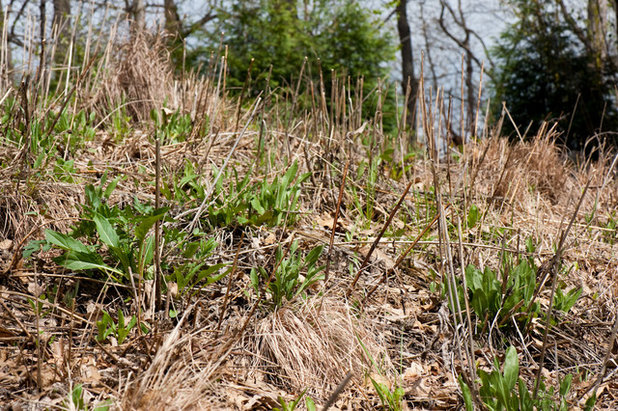
Holm Design & Consulting LLC
How to Spot Small Carpenter BeesAdults. Small carpenter bees are approximately 1/10 to 3/10 inch (5 to 8 millimeters) long. Most adults are a shiny metallic blue or blue-green in color (
C. cockerelli is black), are relatively hairless and usually have a white (or cream) stripe between their compound eyes on their face. Females have fine, short pollen-collecting hairs on their hind legs.
Babies (larvae). Larvae are grub-like and are pale yellow to cream in color. It is unlikely you will see larvae, as they are hidden within plant stems and cavities as they develop and eventually pupate.
Shown: A perennial garden with stem stubble
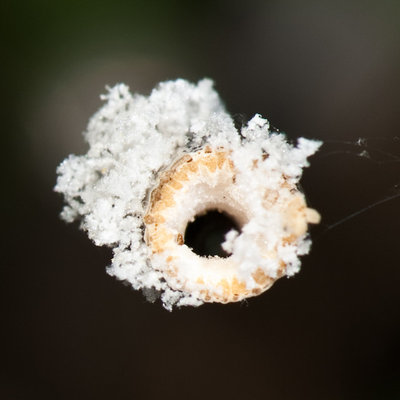
Holm Design & Consulting LLC
How to Lure ThemBesides providing a pesticide-free garden and continuous succession of flowering plants, you’ll need to provide a place where small carpenter bees can nest. It is very simple to do this: When cutting down the perennial plant stems in your garden in the spring (from the previous season), just leave 12 to 15 inches of stem stubble.
Plant stems for nests. Make sure you sow plants with a variety of stem diameters, both hollow and solid stems. The hollow stems can be used by other cavity-nesting insects that need a preexisting cavity. The small stems that are not hollow are ideal for small carpenter bees. In less than a week after cutting the stems, you may see pith shavings billowing out from the stem stubble.
Maintain a bee-safe yard. Do not use pesticides, especially insecticides, in your garden, particularly on your flowering plants.
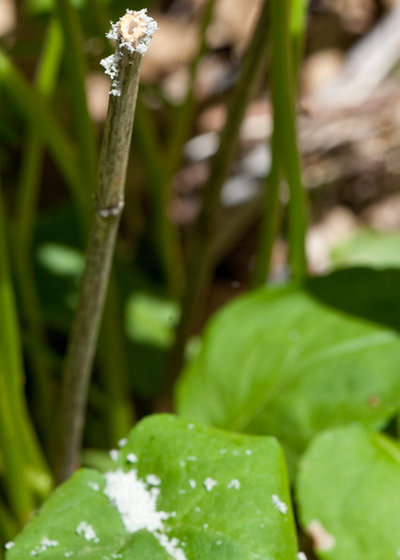
Holm Design & Consulting LLC
Forage plants for adults. Small carpenter bees are generalist pollinators, meaning they visit a wide variety of flowering plants.
Some plants for adults:- Spring: Hepatica (Hepatica spp), bloodroot (Sanguinaria canadensis), wild geranium (Geranium maculatum), violets (Viola spp), spiderwort (Tradescantia spp), harebell (Campanula rotundifolia), beardtongue (Penstemon spp) and golden Alexanders (Zizia aurea)
- Summer: Butterfly milkweed (Asclepias tuberosa), tickseed (Coreopsis spp), vervains (Verbena spp), black-eyed Susan (Rudbeckia hirta) and common ironweed (Vernonia fasciculata)
- Late summer and fall: Stiff goldenrod (Solidago rigida) and aster (any species)
Browse native plants for your region
Shown: The end of a small perennial plant stem that is being excavated by a small carpenter bee
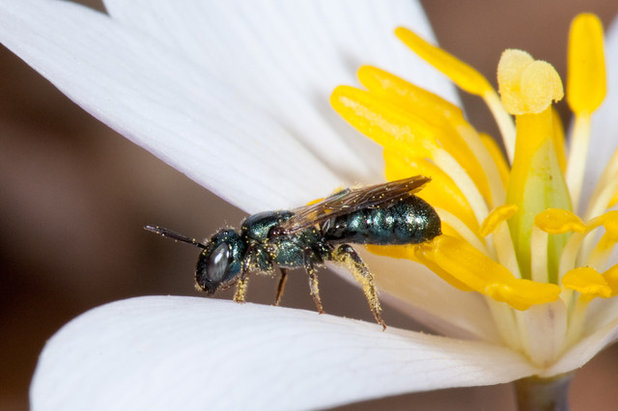
Holm Design & Consulting LLC
Life cycle. In the upper Midwest, Great Lakes and Northeast regions, small carpenter bees usually have one generation per year.
C. dupla has been found to have two generations in Canada. Two generations per year are possible in the southern U.S., because there is a longer growing season.
Female small carpenter bees emerge from the nest as adults, mate and then look for a nest to begin construction. A stem that is vertical or close to vertical is preferred. When a suitable stem is found, the females begin chewing the pith from the center of a plant stem. The cavity in the stem is a long, linear, slightly meandering tunnel. The first provisions (pollen and nectar) are deposited at the bottom of the stem. When enough is deposited for a larva to feed and develop on, an egg is laid.
Small carpenter bees use the stem pith shavings to create brood cell divisions within the plant stem, essentially separating each developing larva into a different room with pith partitions.
Shown: A female small carpenter bee on bloodroot (
Sanguinaria canadensis)
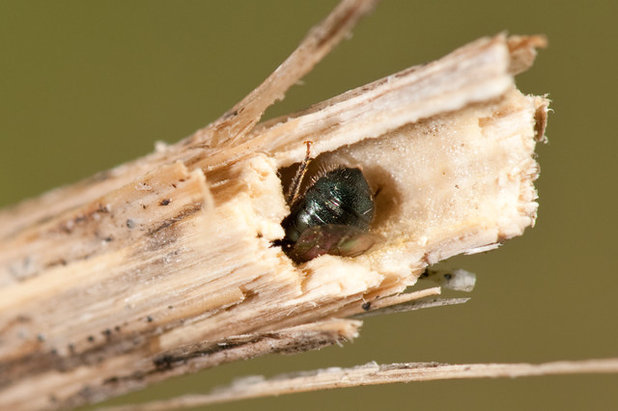
Holm Design & Consulting LLC
Once nest provisioning and egg laying are complete, the female will sit at the entrance of the nest, guarding the nest from insect parasitoids entering.
Small carpenter bees overwinter as adults and can use the same stem that they hatched from earlier that season. This is another important reason to leave those stems in place. Removing the plant debris, bagging it and putting it at the curb means you may be throwing away your bees.
Region by region: What to do in your garden this month
More: How to Help Your Town’s Beneficial Birds and Bugs





